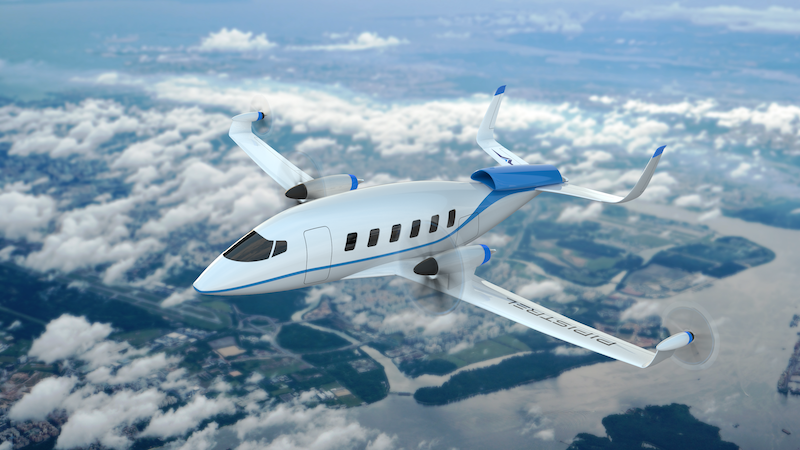Click Here to View This Page on Production Frontend
Click Here to Export Node Content
Click Here to View Printer-Friendly Version (Raw Backend)
Note: front-end display has links to styled print versions.
Content Node ID: 414045
European Union (EU) efforts to achieve a net-zero carbon future for aviation by 2050 are accelerating this year with the launch of a flurry of research and development projects under the auspices of the Clean Aviation Joint Undertaking. Much of the work will focus on developing regional airliners to decarbonize short-haul flying, with prominent aerospace groups—including Honeywell, Collins Aerospace, Textron, Airbus, Rolls-Royce, and GE Aviation—playing key roles.
Under Project Newborn, for example, Honeywell has signed with 17 other partners from 10 European countries to develop a megawatt-cell hydrogen fuel cell propulsion system. Initially, the partners expect the resulting technology to appear in a demonstrator aircraft by Textron eAviation subsidiary Pipistrel, building on recently completed work under the Unifier19 project, focused in the first instance on developing a 19-seat, hydrogen-powered regional airliner.
Slovenia-based Pipistrel, which last year became a key component in Textron’s new eAviation division, has taken a multi-faceted approach to the task of making hydrogen a key part of a green future for air transport. Tine Tomažič, Pipistrel’s director of engineering and programs, told AIN his team is concentrating its efforts on scaling up liquid hydrogen propulsion systems to support viable payload and range and the associated technology for use in suitable airframes.
Pipistrel already has started working with Germany’s DLR aerospace research agency and start-up H2Fly on the HY4 technology demonstrator aircraft. The exercise, expected to see test flights start later this summer, accounts for part of the EU-backed Project Heaven to demonstrate the feasibility of using a liquid, cryogenic hydrogen-powered fuel cell powertrain in an aircraft.
Tomažič said that in terms of optimizing currently available fuel cell technology, Pipistrel mainly focuses on aircraft carrying between 10 and 30 passenger seats. The regulatory constraints of EASA CS-23 (or FAA’s Part 23) certification rules make 19 the "magic number" for a new-generation commuter aircraft.
The company has been incubating plans for a design it calls the Miniliner, which, it says, could make viable a regional carrier's ability to serve small, short-runway airports with potentially four or five sectors of up to around 300 km (163 nm) in quick succession without the need to take on more liquid hydrogen. In fact, Pipistrel believes that an aircraft like the Miniliner could operate economically on routes as short as just 100 to 200 kilometers (up to 109 nm), providing a green alternative to cars and especially in the absence of workable rail links. In theory, that could mean bringing commercial air services to more than half of Europe's 3,000 small airfields–many of which offer only grass runways–and require just 800 to 1,000 meters to land and take off.

The Clean Aviation program timeline calls for the technology to be ready for ground demonstrations in 2026, followed by flight testing in 2030. Work to integrate the powertrain concept advanced under Project Newborn would dovetail with efforts to integrate the technology with an airframe through the wider HERA project.
In related work, Honeywell leads Clean Aviation's TheMa4HERA project, whose name stands for Thermal Management for Hybrid Electric Regional Aircraft. The project involves 24 European partners, including Collins subsidiary Nord Micro, which will help devise new approaches for controlling the temperatures of aircraft equipment other than the propulsion system.
According to Honeywell, the project will develop advanced thermal management components and architectures for next-generation narrowbody aircraft, including those with hybrid-electric propulsion systems. Separately, in 2022, Honeywell started testing a one-megawatt turbogenerator.
HECATE Seeks Quantum Leap in Electric Power Distribution
In January, Collins revealed that it has begun coordinating the development of a high-voltage electric power distribution program under the Clean Aviation HECATE project. Engines and electronics group Safran acts as technical coordinator with Diehl Aerospace, Airbus Defence and Space, and Leonardo, and multiple European universities also are involved. The project, whose acronym stands for Hybrid-Electric Regional Aircraft Distribution Technologies, has attracted almost $44 million in EU and UK government funding.
Collins believes the introduction of hybrid-electric propulsion systems powerful enough for regional airliners will require a "quantum leap" in high-voltage power distribution. According to Todd Spierling, Collins’s principal technical fellow for electrification, the new-generation hybrid-electric powertrains will have to produce higher levels of electrical power to support both the propulsion system and the secondary power needs of other aircraft systems. “They will have to process a lot of high-voltage power and so it’s going to take a very different approach to power distribution and management,” he explained to AIN. “As power levels go up, things become more critical and there is more potential for damage, so you have to be able to instantaneously implement protections.”
The HECATE partners are addressing that challenge by pursuing a goal of ground testing the power distribution system for a 500-kW-plus hybrid-electric powertrain to technology readiness level five by 2025. They plan to conduct simulated high-altitude performance tests at Manchester University’s Aerospace HV facility.
Safran provides primary power distribution equipment and cabling while Thales and Diehl Aerospace work on new power electronics, system control, and energy management technology.
All of the work falls under the broad remit of the EU’s Clean Aviation Joint Undertaking, which seeks to meet goals established under the Paris Accord for zero carbon emissions by 2050 with more than €1.8 billion in public funding. The Clean Aviation timeline calls for the technology to be ready for ground demonstrations in 2026, followed by flight testing in 2030.
Other Clean Aviation projects include HEART and AMBER, under which Rolls-Royce Deutschland and GE Avio, respectively, work on multi-megawatt hybrid electric propulsion systems. Both companies also are working on the direct combustion of hydrogen under the CAVENDISH and HYDEA programs.